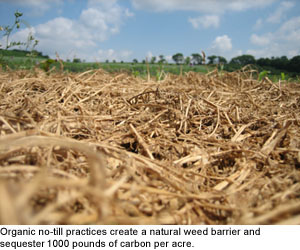30
Jun
Food Inc. Urges Consumers to Use Food Dollars for Safe and Fair Food Production System
(Beyond Pesticides, June 30, 2009) How much do we know about the food we buy at our local supermarkets and serve to our families? In Food, Inc., producer-director Robert Kenner and investigative authors Eric Schlosser (Fast Food Nation) and Michael Pollan (The Omnivore’s Dilemma) lift the veil on the U.S. food industry — an industry that has often put profit ahead of consumer health, the livelihoods of American farmers, the safety of workers, and our own environment.
The movie reveals how a handful of corporations control our nation’s food supply. Though the companies try to maintain the myth that our food still comes from farms with red barns and white picket fences, our food is actually raised on massive “factory farms” and processed in mega industrial plants. The animals grow fatter faster and are designed to fit the machines that slaughter them. Tomatoes are bred to be shipped without bruising and to stay edible for months. The system is highly productive, and Americans are spending less on food than ever before. But, the film asks, at what cost?
Cattle are given feed that their bodies are not biologically designed to digest, resulting in new strains of E. coli bacteria, which sickens roughly 73,000 Americans annually. And because of the high proliferation of processed foods derived from corn, Americans are facing epidemic levels of diabetes among adults and alarming increases in obesity, especially among children. All of this is happening right under the noses of our government’s regulatory agencies, the U.S. Department of Agriculture (USDA) and the Food and Drug Adminnistration (FDA). The film exposes a “revolving door” of executives from giant food corporations in and out of Washington D.C. that has resulted in a lack of oversight and illuminates how this dysfunctional political system often operates at the expense of the American consumer.
In the nation’s heartland, farmers are afraid to talk about what’s happening to the nation’s food supply for fear of retaliation and lawsuits from giant corporations. Our laws today are such that corporations are allowed to patent seeds for crops. As a result, Monsanto, the chemical company that was one of the major manufacturers of Agent Orange and DDT — in a span of 10 years — has landed its patented gene in 90% of the nation’s soybean seeds. Farmers are now forbidden to save and reuse these seeds and must instead buy new seed from Monsanto each season. (These “Roundup Ready” soybeans are genetically engineered (GE) to resist Roundup’s active ingredient, glyphosate, and the resulting increased pesticide use has led to weed resistance.)
Armed with a team of employees dedicated to enforcing their seed patents, Monsanto spends millions every year to investigate and sue farmers – many of whom are financially unable to fight the corporation. Such legal actions have led the state of California to pass a law protecting farmers whose fields are unknowingly contaminated by GE crops.
Food, Inc. also introduces us to courageous people who refuse to helplessly stand by and do nothing. Some, like Stonyfield Farm’s Gary Hirshberg and Polyface Farm’s Joel Salatin, are finding ways to work inside and outside the system to improve the quality of our food. Others are brave men and women who have chosen to speak out, such as chicken farmer Carole Morison, seed cleaner Moe Parr and food safety advocate Barbara Kowalcyk. Their stories, both heartbreaking and heroic, serve to demonstrate the level of humanity and commitment it takes to fight the corporations that control the food industry.
The emphasis of Food Inc. does not center on pesticide use, but it is easy to see how pesticides fit into industrial food production and the problems this film documents. The implications created by a mass-production system seem infinite: increased reliance on glyphosate to control weeds in monocultural GE corn and soybean fields; insecticides to control insects around densely packed feedlots; exposure to farmworkers who lack legal protection; and dietary exposure to a public that does not know the extent to which pesticides are used on much of their food.
It’s important to note that the filmmakers attempted to interview representatives from Monsanto, Tyson, Perdue and Smithfield, but they all declined. Food, Inc. illustrates the dangers of a food system controlled by powerful corporations that don’t want you to see, to think about or to criticize how our food is made. The film reveals how complicated and compromised the once simple process of growing crops and raising livestock to feed ourselves and our families has become. But, it also emphasizes that despite what appears to be at times a hopeless situation, each of us still has the ability to vote on this issue every day — at breakfast, lunch and dinner.
Producer Elise Pearlstein said, “I hope people will want to be more engaged in the process of eating and shopping for food. We have learned that there are a lot of different fronts to fight on this one, and people can see what most resonates with them. Maybe it’s really just “voting with their forks” — eating less meat, buying different food, buying from companies they feel good about, going to farmers markets. People can try to find a CSA — community supported agriculture — where you buy a share in a farm and get local food all year. That really helps support farmers and you get fresh, seasonal food. On the local political level, people can work on food access issues, like getting more markets into low income communities, getting better lunch programs in schools, trying to get sodas out of schools. And on a national level, we’ve learned that reforming the Farm Bill would have a huge influence on our food system. It requires some education, but it is something we should care about.”
For more information, visit Beyond Pesticides’ organic food program page.











 Incidents with flea and tick products can involve the use of spot-on treatments, sprays, collars and shampoos. However, the majority of the incidents reported to EPA are related to flea and tick treatments with EPA-registered spot-on products. Spot-on products are generally sold in tubes or vials and are applied to one or more localized areas on the body of the pet, such as in between the shoulders or in a stripe along the back. This advisory pertains only to EPA-registered spot-on flea and tick products; these products have an EPA registration number on the label.
Incidents with flea and tick products can involve the use of spot-on treatments, sprays, collars and shampoos. However, the majority of the incidents reported to EPA are related to flea and tick treatments with EPA-registered spot-on products. Spot-on products are generally sold in tubes or vials and are applied to one or more localized areas on the body of the pet, such as in between the shoulders or in a stripe along the back. This advisory pertains only to EPA-registered spot-on flea and tick products; these products have an EPA registration number on the label.

